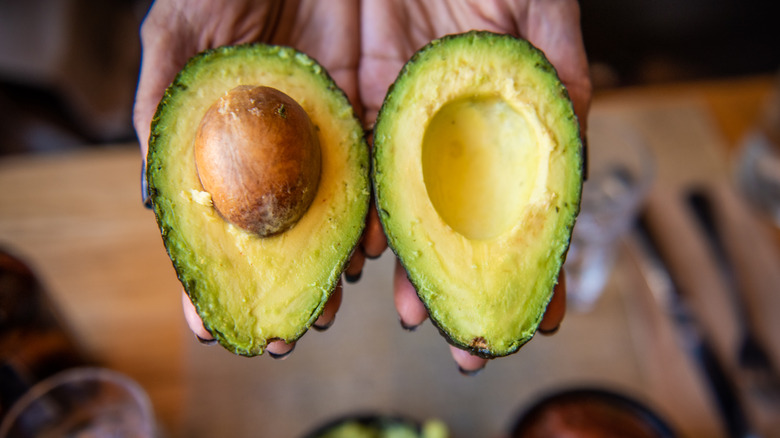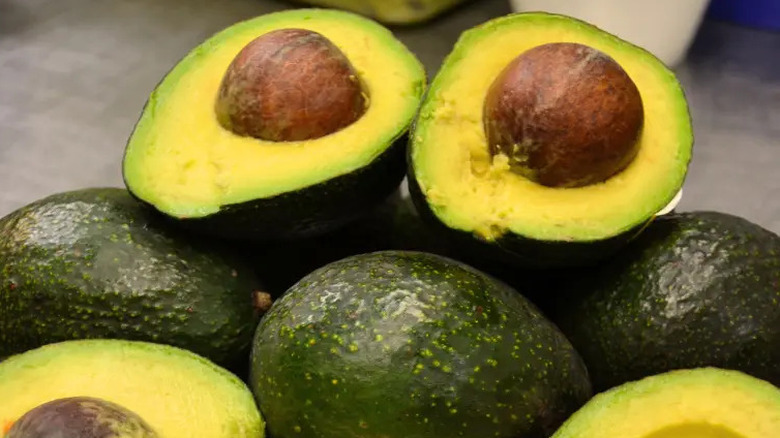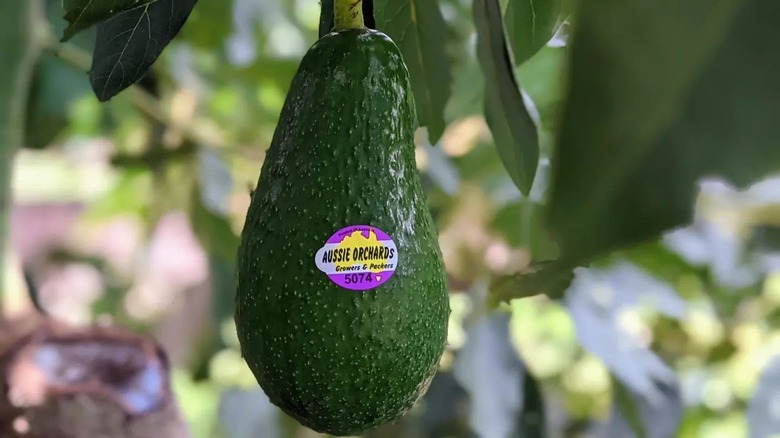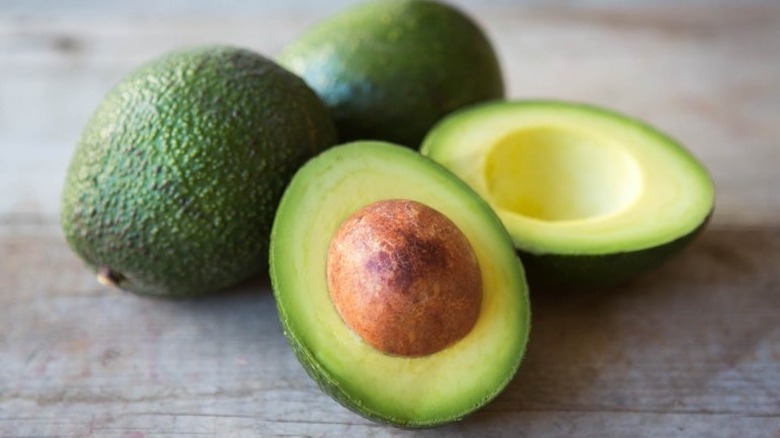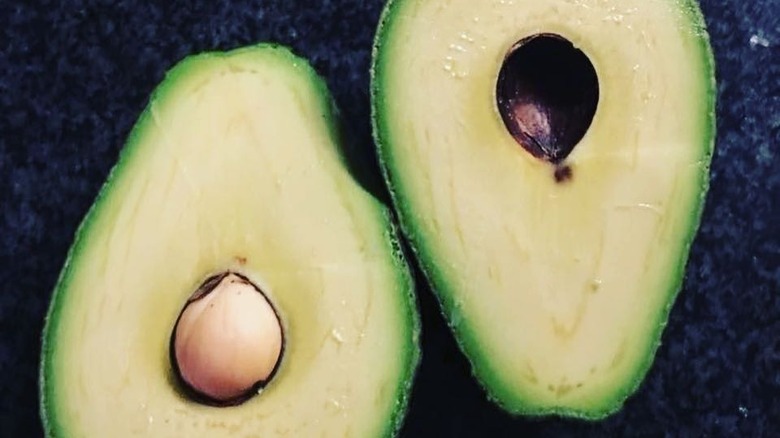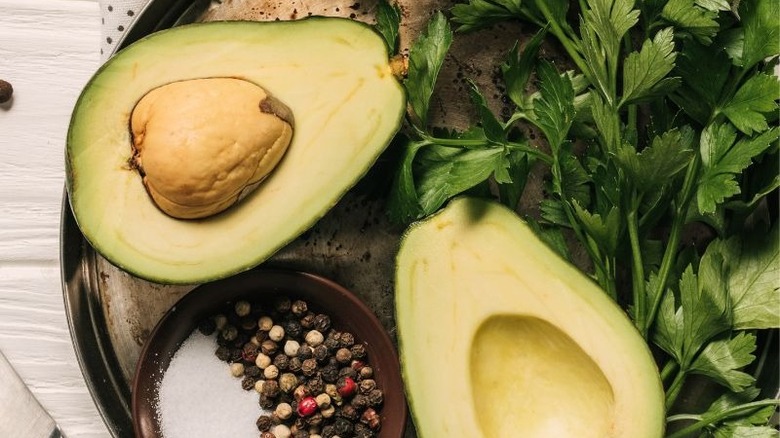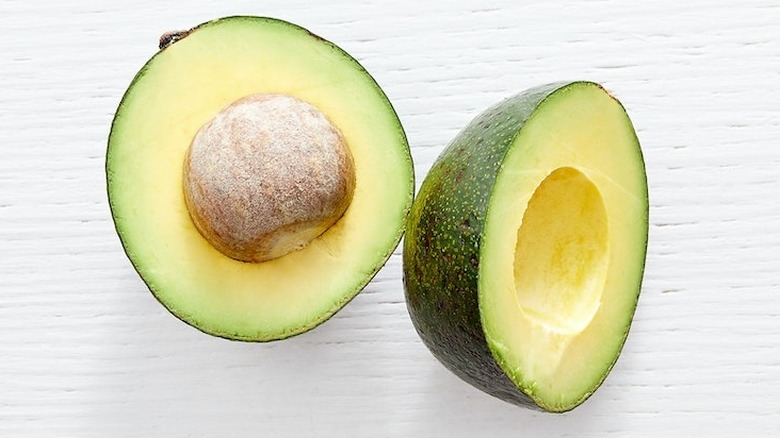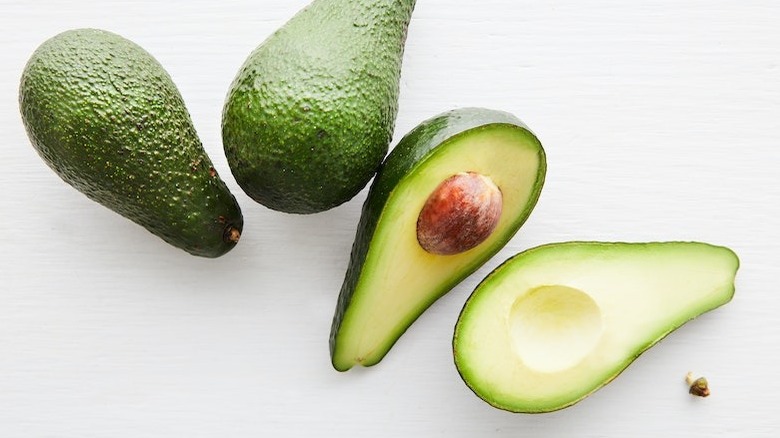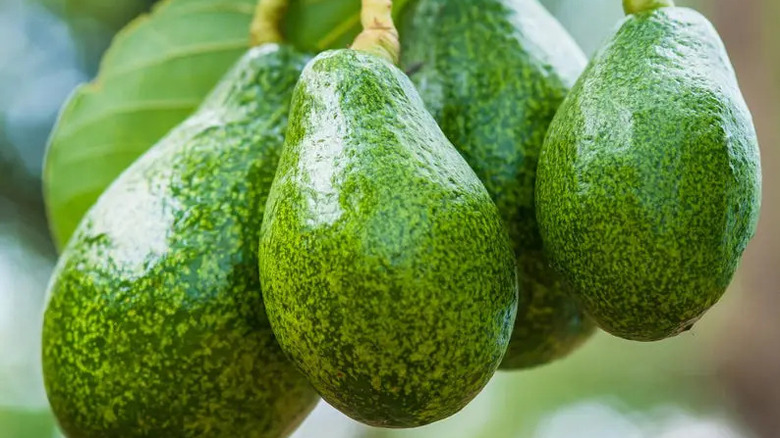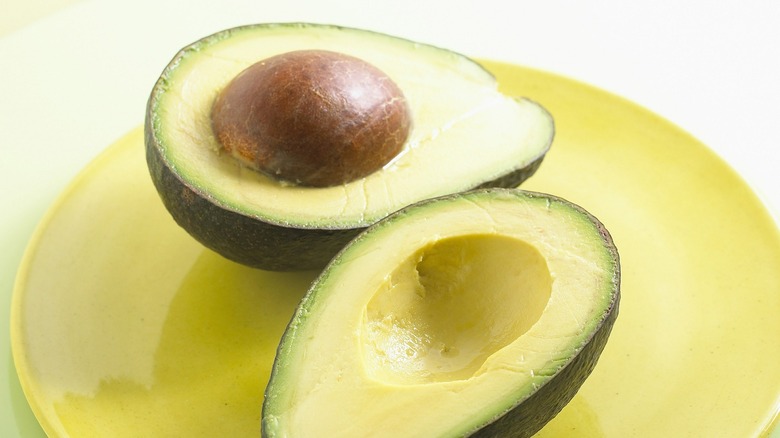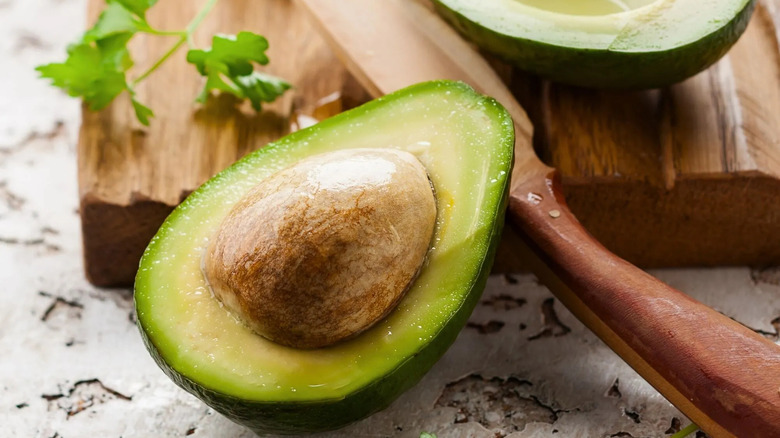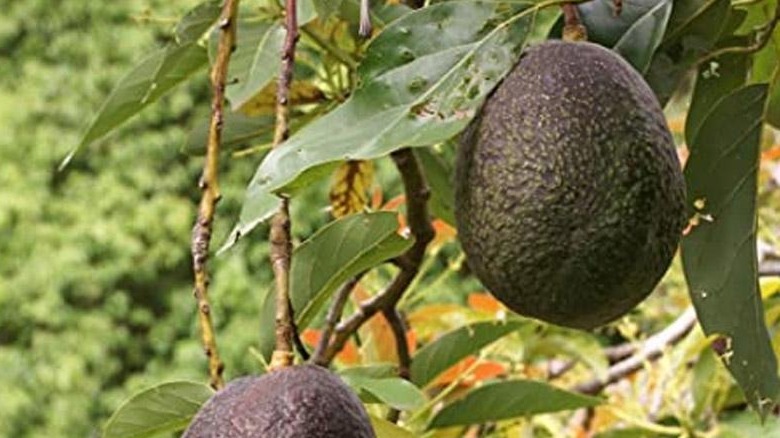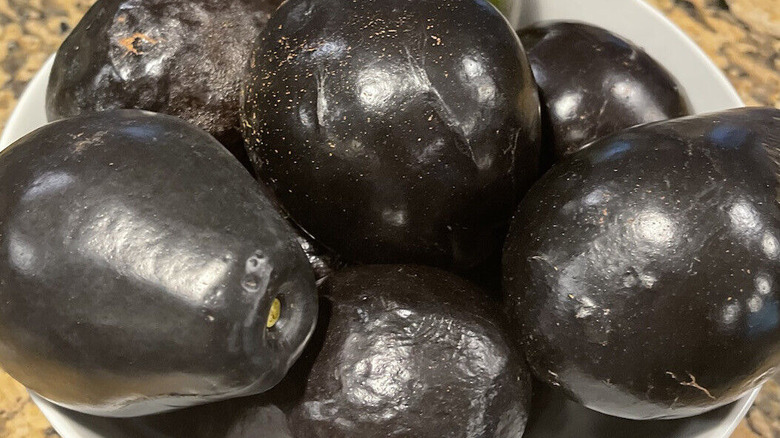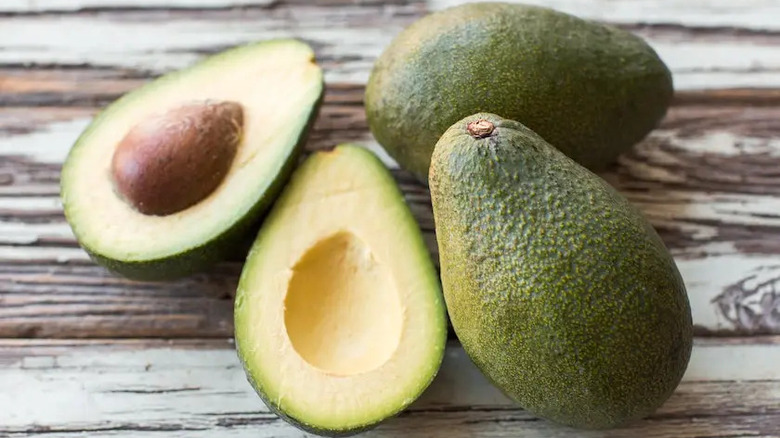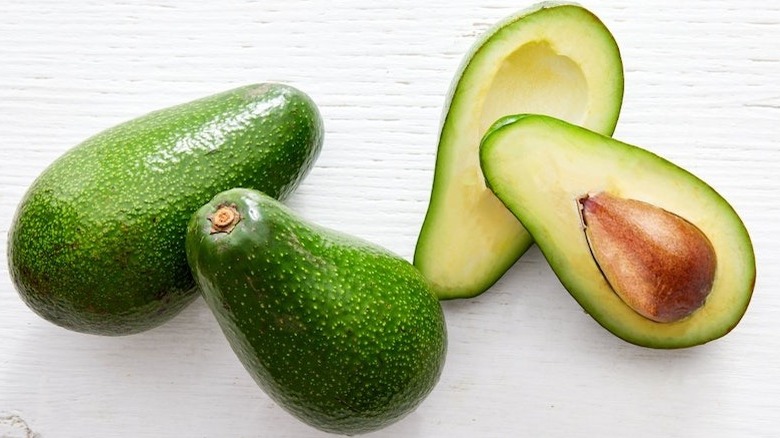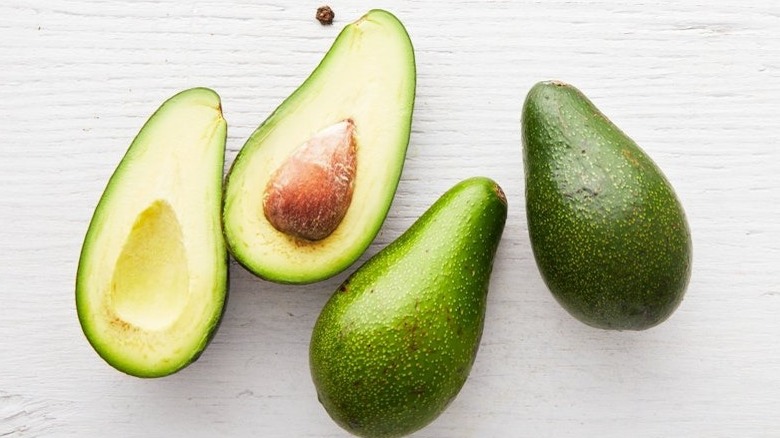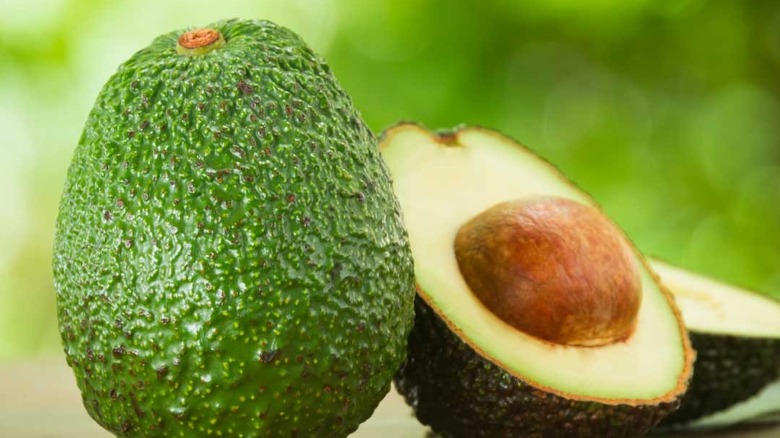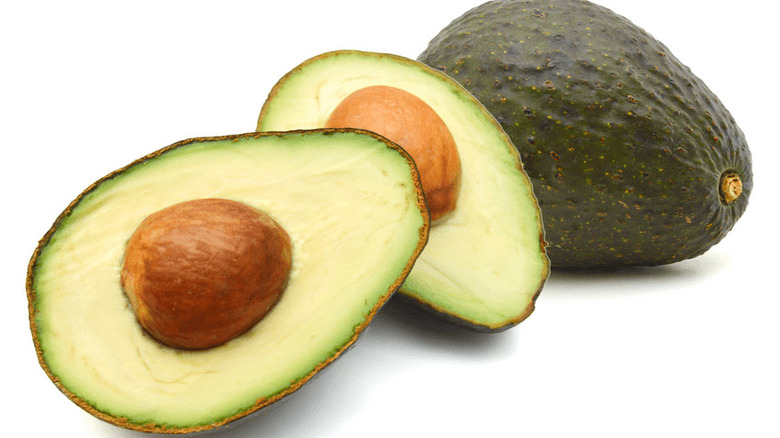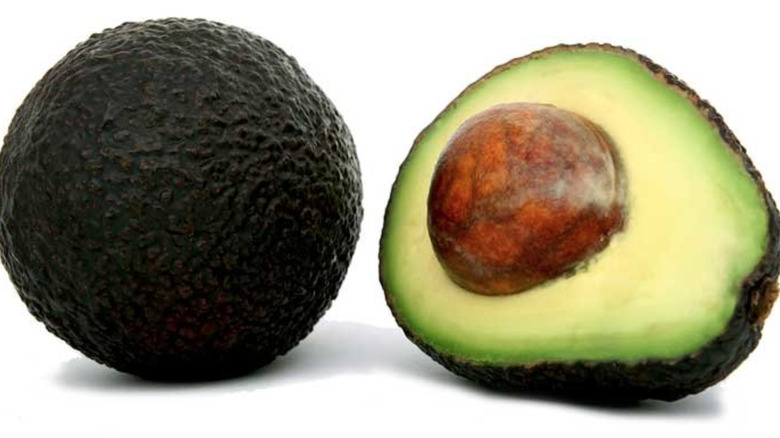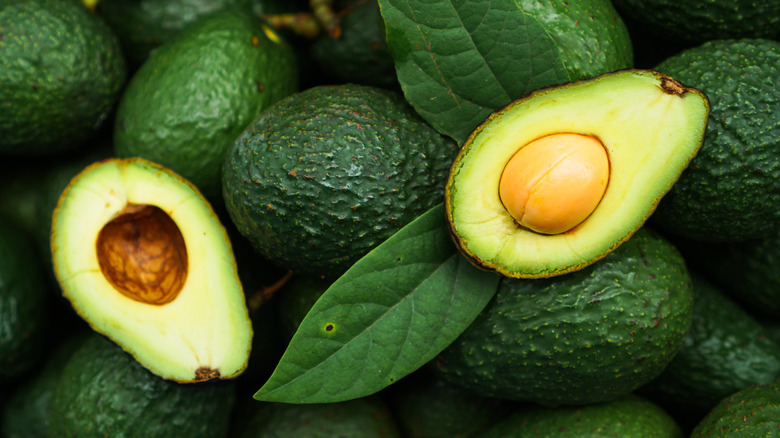Know Your Avocado Varieties And When They're In Season
You've mashed it, smashed it, sliced it, and diced it. You put an egg, bacon, and cheese on it. And you've gloriously slathered it with hot sauce, ketchup, balsamic glaze, and everything but the bagel seasoning. But do you even know your favorite avocado's real name? (Rude.) Ever thought that it might be Gwen or Wilma? Oh, and p.s., that avocado toast trend you thought you started in the 2010s? Nope! Avocado toast is so early-ish 1900s.
We went global for avocado season, picking the ripest fruit on the tree — or waiting for the split-second it hit peak maturity and then maniacally tried to whip up some fried avocado tacos like our lives depended on it. We can't help it. Perfectly creamy, nutty, buttery avocados have us wrapped around their lil pinkies ... if they had those.
From Miami to Egypt, and every last farmers market in between, these varieties drive the $15 billion avocado industry to the limit every time they hit the produce section. So what's good, and when is it trending? Hold onto your Hass, we're going full guacamole.
Choquette
Meet the coquettish Choquette avocado. She's a popular Miami-grown gal, who also goes by the nicknames "Florida Avocado," or the more fun "Alligator Pear." She drives a convertible and likes long walks on the beach, and a cocktail umbrella in her key lime daiquiri.
Choquette varieties are hefty in size, with shiny, glossy skin that's easy to peel. They reveal a creamy, nutty flesh that was born for fresh seafood and salads. If this sounds a-peel-ing (Hey, those crickets are from the avocado orchard!), mark your calendar for their autumn harvest. These gator pears are typically ripe and ready from October all the way through December. This holiday, ditch the fruitcake and gift a fruit people actually want.
Better yet, get a tree! Choquettes grow best in the southernmost parts of the east and west coasts of the United States. Their yellow blossoms smell like pineapples, and the fruit grows to be 6 inches long, at 3 pounds each. That's a lot 'o avocado.
Shepard
Throw another Aussie'cado on the barbie! From February through May, the Land Down Under goes crazy for their Shepard avocados. A little different than the Hass variety that can also be found in Australia, Shepards feature a flesh that's a bit more firm, and therefore slightly less smashable for toast. But they're still just as delicious in an avocado emergency.
Shepard avocados taste beautiful and buttery, but their sparkling green skin makes it hard to tell 1. When they're ripe, and 2. When they're rotten. The color never changes. They're ageless! But even during their harvest season, they're not always ready to eat. One way to tell if this variety is good to go, is by pressing on the top stem portion. If it's soft, dig in. Anything else means you have to wait and chill before getting your avocado on.
One superpower of the Shepard is its freakish ability to remain green once it is cut. While they might get a bad rap compared to their softer, earlier-in-the-season cool-kid cousin Hass, the Shepard's ability to hold onto its looks makes it a beautiful addition to salads, spring rolls, or fresh garden tomatoes and basil.
Gwen
Of course Gwen is, like, from California. She's also a descendant of her grandpa Hass. Invented at the University of California, Riverside back in the '80s, the dwarf Gwen tree was designed to grow a lot of fruit in a small space. And from April through September, it does just that.
Gwen takes all the best things about the Hass — including the same bumpy skin — and wraps them up in a rounder, slightly larger shape. The tree produces loads of fruit despite its smaller amount of real estate, so it makes a great tree for a small backyard. And unlike Hass, it keeps its green hued skin, even when it's ripe.
Thanks to a slightly more complicated need for cross-pollination, Gwen hasn't made the nationwide splash fans had hoped. But this variety is still a favorite for SoCal locals. Its soft and nutty flesh has a buttery mouthfeel which just might make you forget you had to book a vacation to San Diego, California just to taste this thing.
Maluma
Okay, yes, it's Maluma, but not the Colombian rapper. This Maluma is an avocado variety with its roots in South Africa. And while it's been called "Hass-like," in reality, it's primed to become a serious competitor in the Hass-dominated market.
Maluma avocados feature a creamy, nutty flavor, with a familiar pebbly skin, and typically hit the market every year from October through December. The variety has since made its way to Spain, with a sizable presence in Peru. And because it likes colder weather, it's also harvested August through November in New Zealand. Do the math, and you can Maluma five months out of the year.
These guys are early-bloomers, known as one of the first avocados to hit the market each year. If you like Hass, chances are you're Team Maluma, too.
Lula
Lu, it's no secret ya' got a big ole seed. But that rich, sweet meat around it makes one holy guacamole. Lulu avocados became a thing in Florida, back in 1919 when trees first produced a crop. The variety was developed by horticulturalist George Cellon, who then named it after his wife, Lulu. Local growing season is October through December, and if you happen to get your hands on one, you're celebrating a luxury of days gone by.
Lula was once the jewel of the Florida commercial agriculture industry, that is, until more popular kids came along. Maybe their seeds were a little smaller, maybe their marketing was a little better. But no one could erase Lula's legacy as a trailblazing Floridian — who is also an avocado.
Bust out the good china; Lula transcends the avocado latte trends with a touch of class. While she's assumed to be a cross between Guatemalan and Mexican avocados, some say the Lula pulp is even creamier than Hass. (Ooo, that hass to hurt.)
Reed
Born in Carlsbad, California, Reed avocados can max out at a whopping 2 pounds each! Exactly how tree branches can hold all that fruit beats us, but luckily they do. We can get our little paws on these beauties from May through October. And while most of them grow in California, Florida has jumped in the game as well.
Guys, in case the Reed variety is new to you, these avocados are enormous. They're big and round, bright green with yellow insides, and can reach sizes up to 40 ounces. That's 2.5 pounds of creamy avocado dip.
This variety can be tough to find nationally, but if you live near an area where they grow, they're absolutely worth tasting. Serving up a bold, nutty flavor, with a ridiculously silky smooth texture, call the police because it's illegal to taste this good.
Pinkerton
Flash back to the '70s when these luscious avocados made their debut on the Pinkerton Ranch, just outside of Los Angeles in sunny Saticoy, California. (Okay, somehow, they just look like '70s avocados. Maybe it's that longer, bell bottom-like shape?) And, back to current times, you can find Pinkerton avocados at the farmer's market or on Instacart from December through April.
Even better, they have a teeny tiny seed in comparison to their size, which means they're packed with loads of nutty, buttery flavor. And about that early spring timeline ... if you stumble on an egg hunt around Easter, maybe go with Pinkertons instead of plastic eggs. They're actually edible, and so much harder to find in the grass.
Y'know, speaking of eggs, we could really go for an egg and avocado brekkie sammie right about now. Or a scramble with avocado, smoked sausage, and cheese. Siri, set an alarm for Pinkerton season.
Fantastic
Finally, an avocado that knows how delicious it is, and then named itself appropriately. Fantastic! Also known as the Pryor and Del Rio varieties, the Fantastic fruit is ready for action anytime between August and October. And by action, we mean caprese stuffed avocados with a drizzle of balsamic glaze, topped with a sprig of fresh basil. Be still our beating hearts.
Actually maybe this variety should be called Fantastico, considering its Mexican heritage. Or Rambo, since it can brave some pretty harsh conditions with no problem. Apparently, a little frost at 15 degrees Fahrenheit is nothing for this tree. Because of this hardiness, a Fantastic sapling is great for those of us who, you know, maybe don't have the brightest green thumbs.
The fruit packs a high oil content, which means, hello, buttery flavor for days. Fantastics can grow anywhere from the tippy tips of southern California, Texas, and Florida, into the middle and coastal South of the United States. You know what that means? We can get them just about anywhere during the late summer and fall. All together now: That's super fantastic!
Mexicola Grande
If you love eating an avocado, and its skin, and possibly making tea with the leaves of its tree, then the Mexicola Grande variety is right up your alley. And from August through October, you'll be living that Mexicola Grande life like you meant it, amigo. You'll usually find them along the southern and western coast of the United States.
A native of Pasadena, California, the Mexicola Grande avocado is actually the seedling child of the Mexicola avocado. Not quite as fruitful as its dear old dad, little Mexicola Grande probably got its name because it grew bigger than anyone else in its family.
The craziest part here isn't just how cold-hardy this tree is — able to stand temps in the low 20's Fahrenheit. We're even more impressed with how you can eat its extremely thin, shiny black skin, which tastes like anise. Also featuring a similar flavor profile, the edible tree leaves have been used in teas and Mexican cuisine, both for seasoning and as a digestive aid.
Bacon
You 1,000 percent have the wrong idea about this thing. And we know that, because so did we. Tragically, this is not an avocado that was developed to taste like bacon, and to therefore assume two spots in a BLT+A, the likes of which the brunch universe has never seen. We have a serious bone to pick with the heartless meanie who named this thing. (Ugh, James Bacon, why? It might have been a little less of a tease to name it Buena Park, after the California town where it was cultivated. Literally any other name would work. Norman. Whatever.)
The (unflavored like bacon) Bacon avocado hits SoCal farmers markets in the winter season from November through March. Sadly for non-locals, the span of its empire ends at the Nevada-Arizona border.
Silver lining, the Bacon (sigh) avo doesn't offer anything extra special, compared to other varieties. It's nutty in flavor, with light yellow-green flesh, and its thin skin happens to be easy to peel, if you're into that. All in all, the Bacon avocado tastes nothing like bacon and thus earns an F rating. Not that we're judging anything. No offense, Bacon avocado lovers. But if we were rating it, which we're definitely not ... F.
Cleopatra
We're already fascinated by the eyeliner we can only assume is featured somewhere on this fruit — or should be. Cleopatra season hits from July through December. You might find them at certain specialty stores in the United States. Even though they're zoned to grow in the South, they're a relatively new kid on the market, and are still finding their footing in the U.S.
This fresh green-colored, creamy fruit was developed in Egypt, and named — hello — in honor of Cleopatra, the non-avocado Queen of Egypt. The tree is also extremely fertile. We wouldn't expect anything less from this royal fruit.
Here we might put together a recipe that celebrates Cleopatra's heritage. Perhaps an avocado hummus, a roasted carrot and avocado salad, or a creamy lentil soup topped with slices of avocado and fresh cheese crumbles. Can't stop, won't stop. Already starting to imagine the pyramids remodeled as pear-shaped avocados. Did we just say that? Yes, we did.
Brogdon
A native of Winter Haven, Florida — also home to the indomitable LEGOLAND — the Brogdon avocado steps in where the Hass avocado can't exactly ... fruit. (It's a natural humidity thing, everyone goes through it.) With a harvest season spanning July to September, Brogdons taste similar to Hass. (They might be Hass impersonating a different variety because we have yet to see them both in the same place at the same time.)
When they're ripe, they develop a glossy, dark purple skin, with a beautiful velvety, grassy-green and nutty pulp that melts in your mouth. Lots of oil in a slice means loads of healthy fats to get you that vitamin E. Of course, it's a different thing if your avocado lands in a bowl of pasta, or on top of a fried chicken sandwich. Tomato, to-MAH-to.
Brogdon trees can survive a chill to roughly 32 degrees Fahrenheit. So even though they're a product of the warm ocean breezes of the Sunshine State, you'll also find them in cooler climates, too.
Fuerte
Named after the Spanish term for "The Hulk" (okay, fine, it means "strong"), Fuerte avocados make their annual debut every spring during the months of March, April, and even as late as May. And they've been rocking Californians' world since before avocados were cool.
Literally launching the entire California avocado industry as we know it (What? There was a time when Wholly Guacamole wasn't in stock?), a botanist by the name of Carl Schmidt took a little sample of the Mexican Fuerte tree, brought it home to Altadena, California, and then bing, bang, boom: avocado mania.
The humble Fuerte may just be the fine-dining version of avocados. Its elegant, pear-shaped body reveals a velvety pulp that you might just want to taste on its own. A standout in a field of similar-tasting varieties, this fruit features notes of lemon, hazelnut and a touch of freshly mowed grass. If you see one, grab it before someone else does. Fuerte isn't Fuert'n around when it comes to flavor!
Ettinger
Ever since Ettinger avocados made their way to the United States in 1954, they've been enjoying a rather luxurious harvest season running from October through March. That makes sense though, considering they're grown in — where else — California.
Ettingers are lighter in just about every way, compared to other avocado varieties. They're mellower in taste than the Hass, and also pack a lower percentage of oil than most. But don't count them out as a nutritional powerhouse. They're loaded with fiber, potassium, and folic acid, as well as vitamins K, C, and B. These avocados do a body good.
This variety is also known to produce the occasional "cuke." And what pray tell is a freakin' cuke, you ask? It's a mini seedless avocado that does its ripening along the rest of the fruit on the tree. Except it maxes out pretty small, like a little pickle-shaped guy that can be eaten skin and all. Um, just curious, where does a person buy the tree that only makes cukes? Asking for a friend.
Zutano
From October through February, don't be surprised if you spot a pile of Zutano avocados on display at the supermarket. Zutanos grow like crazy, are extremely hardy, and act as a pollinator for even more avocado varieties.
One thing though, before you slice into one of these babies, they're lighter on the oil than you might be expecting. And with more water content in place of those fats, they become fiber city. If you like a rich, creamy, silky pulp, this definitely isn't it. Zutanos function as the default substitute fruit when Hass is off-season. But, let's be real. This is not an equal swap. And it seems like fans have noticed.
California is still pumping Zutano avocados into the rest of the market, but prices for these "lesser Hass" avocados have been on the downward slope. We're guessing that purists have likely gone avocado-free, instead of subjecting themselves to something that looks like an avocado, and tastes like nothing.
Monroe
As the iconic Marilyn Monroe once said, "Give a girl the right avocado and she can conquer the world." Okay, maybe she said "shoes," but for our purposes, it's avocados before Manolos. From November through January, the Florida-born Monroe avocado comes in hot with 2-pounders that boast more curves than the Blonde Bombshell herself.
This variety is creamy and nutty on the inside, with none of the fiber-like texture of some of the less oily types. She might be from Florida, but now you'll find Monroes all across the southern states, as well as Hawaii and Puerto Rico.
As an homage to the Monroe avocado's debut in 1932, we're cooking up a recipe from the actual '30s! And you'll never believe it, it's an open-faced bacon and avocado sandwich ... otherwise known as avocado toast. You know how it goes: toast, mashed avocado, salt, paprika, and ketchup, topped with slices of savory bacon. As the author notes, "Serve these open face sandwiches for breakfast, if you wish something quite out of the ordinary and very good." We do. We do wish that.
Sharwil
It seems that somebody got the short end of the stick on the name situation. Sharwil? Apparently, the Australian-born fruit was gifted a mashup of names from its two developers: Sir Frank Sharpe and JC Wilson. (Still think they could have gone with Sharson.) Either way, from November through February, you'll find Sharwil rockin' and rollin' in the produce section.
Cool things first, Hawaii grabbed hold of Sharwil and took him from relative unknown to massive legend. As it stands, it's the only variety of avocado that's approved by the USDA to be shipped out of Hawaii and into the other 49 states. Sharwil for the win.
The green, gator-like skin of the fruit gives way to a super creamy pulp and one of the smallest seeds in avocado land. And considering its oily makeup, the longer these avocados ripen, the richer and more buttery they taste. Plus, on the Big Island, they're often grown alongside macadamia nuts and coffee, which encourages each crop to shine its brightest. Okay, stop. We have to stop. Is this even real right now? Is this the part where a unicorn flies over the orchard and dusts the avocados with rainbow magic glitter from its butt? Ugh, Sharwil — Sharson ... you beautiful beast.
Brazos Belle
She's Brazos Belle, and from August through October and even November, she dominates the market like a stone cold boss. This Texas original was named in honor of The Lone Star State's iconic Brazos River, and she's gently floating to a store near you.
Brazos Belle avocados mature into a rounded shape with bright green bumpy skin, and a slightly sweet, rich, nutty flavor to the pulp. Texturally, they're of the butterlicious variety, to everyone's delight. Brazos Belle is technically a Wilma avocado clone, so you might see both names featured side by side at the farmers market. (For the record, they're not the same. No matter how many people tell you otherwise.)
Belles make lovely shade trees — that is, if you don't mind possibly being klonked in the head by one of the fruit. But if you can manage to pluck your Brazos Belle avocados from the branches at just the right moment, your next Texican guacamole appetizer will be hotter than a fur coat in Marfa.
Hass
Like a new Taylor Swift breakup album, questionable '90s fashion, and an unattended garlic herb cheese log at a holiday party, we can't get enough of Hass avocados. And during prime pickin's in July through November, we would legit elbow the world's sweetest granny out of the way to get the last (ripe) one at the store.
Of all the avocados in the entire universe, 95 percent of the ones we eat in the United States are the Hass variety. (That translates to all of us eating a whopping 2 billion pounds for the year in 2020.) And despite the lure of the other varieties, out of all the avocados farmed in California, more than 95 percent are Hass. You know it when you taste it: that signature creamy, nutty, sweet and buttery, get out of town, heavenly Hass.
The U.S. success of the Hass is all thanks to a Milwaukee-born mailman, Rudolph Hass. During the initial tropics-adjacent fruit trend in the '20s — hashtag exótico! — he tried his hand at growing a few avocado trees in his yard in La Habra, California. The tree that he almost cut down because it looked like a dud went on to became the singular sensation of nearly a century's worth of avocado toast across the nation. The original Hass "Mother Tree" finally succumbed to Mother Nature in 2002, at the ripe ol' age of ... 80-ish.

